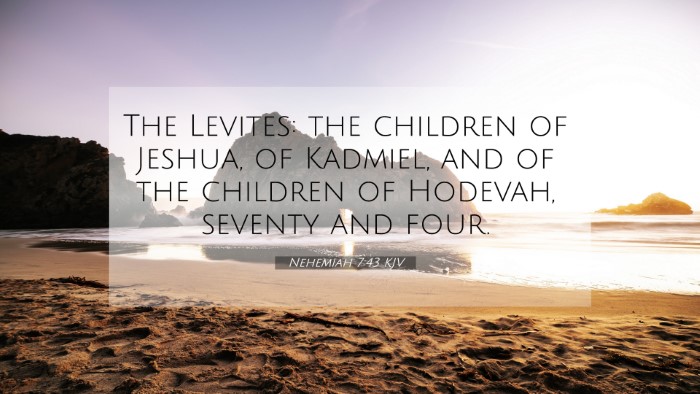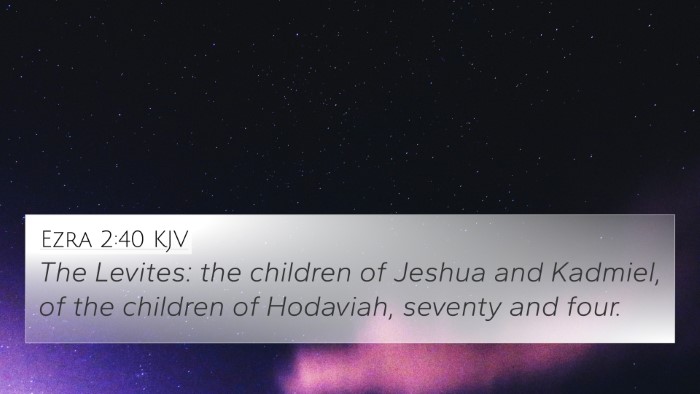Understanding Nehemiah 7:43: A Comprehensive Analysis
Nehemiah 7:43 mentions specific groups of people returning to Jerusalem, providing a glimpse into the restoration of the Jewish community after the Babylonian exile. This verse serves as a foundational element in understanding the greater narrative of restoration within the Old Testament.
Verse Context
In the context of Nehemiah, the focus is on rebuilding Jerusalem's walls and the community's return. This particular verse lists names that highlight the leaders and families involved in this collective effort. The significance of naming in the Bible often points to recognition and honor in God's community.
Commentary Insights
Based on insights from public domain commentaries, we can glean several layers of meaning from Nehemiah 7:43:
- Matthew Henry: Emphasizes the importance of detailed records in scripture. Each name represents a family contributing to the restoration, reflecting God's careful preservation of His people and their histories.
- Albert Barnes: Points out that the act of listing these names signifies acknowledgment of their roles in God’s promise for returning and rebuilding. Furthermore, it underscores the importance of family lineage within the nation of Israel.
- Adam Clarke: Notes that genealogy was critically important to the Israelites, as it established identity and faithfulness to God's covenant. This passage reflects their unity and commitment to renewing their relationship with God.
Bible Verse Cross-References
Nehemiah 7:43 can be cross-referenced with several verses that share similar themes of restoration, community identity, and covenant faithfulness:
- Ezra 2:1-70: This passage recounts the list of those who returned from exile, echoing the names given in Nehemiah 7.
- Nehemiah 11:3-4: Discusses the leaders and their contributions in establishing the community in Jerusalem.
- Jeremiah 29:10: Addresses the prophetic promise of return from exile, underlining God's commitment to His people.
- Isaiah 11:11: Foretells the return of a remnant of Israel, reinforcing themes of restoration.
- Ezekiel 37:21: Conveys God's promise to gather His people, resonating with the heart of Nehemiah's mission.
- Daniel 9:2: Reflects the timing of the end of the desolation, connecting to the re-establishment of Jerusalem.
- Exodus 6:6-8: Reminds of the covenant God made with His people, laying the groundwork for understanding their restoration.
Connections Between Bible Verses
The connections between Nehemiah 7:43 and other scriptures illustrate the continuity of God’s message throughout the Bible:
For instance, the mention of genealogies connects the Old Testament emphasis on lineage with New Testament themes found in Matthew 1:1-17, which traces Jesus’ ancestry, fulfilling God’s promise made to the patriarchs.
Cross-Referencing Biblical Texts
A thorough study of Nehemiah 7:43 can serve as a template for understanding how to utilize tools for Bible cross-referencing:
- Utilizing a Bible concordance can aid in finding significant names and locations that recur throughout scripture.
- Employing a Bible cross-reference guide enhances one’s understanding of thematic connections.
- Practicing cross-reference Bible study enables a holistic view of biblical themes.
- Identifying how to use Bible cross-references assists in sermon preparation and personal study.
- Leveraging a Bible cross-reference system will elevate one’s interpretative skills.
Inter-Biblical Dialogue
By studying Nehemiah 7:43 in light of its biblical context and cross-references, we engage in inter-Biblical dialogue where Old Testament prophecies harmonize with New Testament fulfillments. This creates enriching discussions for personal growth and theological exploration.
Conclusion
In summary, Nehemiah 7:43 not only records the names of those who returned but represents the broader theme of restoration and covenant faithfulness throughout scripture. Engaging with this verse through cross-references and commentary insights enhances our understanding of God's unwavering commitment to His people.




